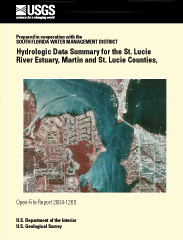
USGS Open-File Report 2004-1265
Prepared in cooperation with the South Florida Water Management District
2004
 |
Select an option: |
| Summary of Hydrologic Data and Storm Events State and Flow Salinity and Water Temperature Turbidity and Suspended-Solids Concentration Effects of Storm Events Conclusions References Cited Appendix |
A hydrologic analysis was made at three canal sites and four tidal sites along the St. Lucie River Estuary in southeastern Florida from 1998 to 2001. The data included for analysis are stage, 15-minute flow, salinity, water temperature, turbidity, and suspended-solids concentration. During the period of record, the estuary experienced a drought, major storm events, and high-water discharge from Lake Okeechobee.
Flow mainly occurred through the South Fork of the St. Lucie River; however, when flow increased through control structures along the C-23 and C-24 Canals, the North Fork was a larger than usual contributor of total freshwater inflow to the estuary. At one tidal site (Steele Point), the majority of flow was southward toward the St. Lucie Inlet; at a second tidal site (Indian River Bridge), the majority of flow was northward into the Indian River Lagoon.
Large-volume stormwater discharge events greatly affected the St. Lucie River Estuary. Increased discharge typically was accompanied by salinity decreases that resulted in water becoming and remaining fresh throughout the estuary until the discharge events ended. Salinity in the estuary usually returned to prestorm levels within a few days after the events. Turbidity decreased and salinity began to increase almost immediately when the gates at the control structures closed. Salinity ranged from less than 1 to greater than 35 parts per thousand during the period of record (1998-2001), and typically varied by several parts per thousand during a tidal cycle.
Suspended-solids concentrations were observed at one canal site (S-80) and two tidal sites (Speedy Point and Steele Point) during a discharge event in April and May 2000. Results suggest that most deposition of suspended-solids concentration occurs between S-80 and Speedy Point. The turbidity data collected also support this interpretation. The ratio of inorganic to organic suspended-solids concentration observed at S-80, Speedy Point, and Steele Point during the discharge event indicates that most flocculation of suspended-solids concentration occurs between Speedy Point and Steele Point.
By Michael J. Byrne and Eduardo Patino, 2004, Hydrologic Data Summary for the St. Lucie River Estuary, Martin and St. Lucie Counties, Florida, 1998-2001: U.S. Geological Survey Open-File Report 2004-1265, 19 p., plus appendixes.
U.S. Department of the Interior,
U.S. Geological Survey
email Michael J. Byrne
Ft. Myers, Florida, at
mbyrne@usgs.gov
| AccessibilityFOIAPrivacyPolicies and Notices | |
 |
|